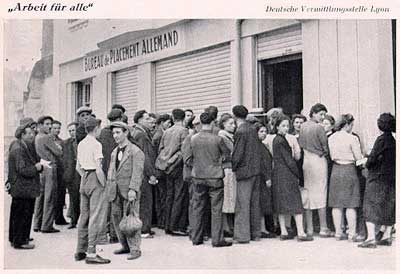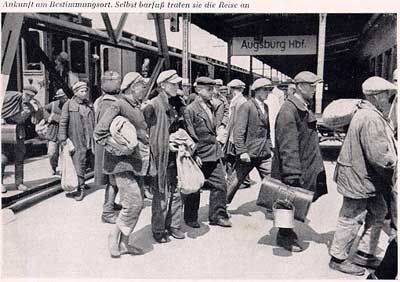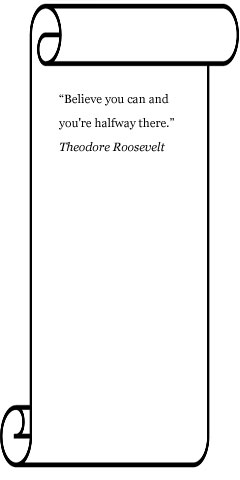| Forcing the Issue:
Wartime Labor in the Third Reich
By David Meyler
September 2013
In 56 B.C., during his conquest of Gaul, Julius Caesar made
an unprovoked attack against the Veneti federation, centred
around present-day Brittany. He used the pretext of revolt,
but critics then and since have called the campaign nothing
more than a massive slave drive. According to his own figures,
Caesar sold off the entire population as slaves, some 60,000
men, women and children. The incredible profits realized on
the busy Roman slave markets allowed the would-be emperor
to secure the loyalty of his soldiers, bribe the support of
the Roman mob and buy crucial votes back in the Senate.
Human resources here takes on a whole new meaning.
When histories write of economic warfare in the Second World
War, we tend to think of oil, or iron, or other strategic
raw materials. But by 1941, Nazi Germany found itself, like
Rome in the time of Caesar, with an insatiable hunger for
cheap human labor.
The German economy had not been geared for a long war. The
rapid expansion of the armed forces by the end of 1941 put
a severe stress on the civilian economy. Each year these stresses
increased. With so many young men at the front or in support
services, there was a shortage of skilled and unskilled labor,
both in the countryside and in the cities.
In the Soviet Union and to a lesser extent in the West,
women replaced male labor, especially in key war industries,
but this did not find a place in Nazi ideology. The other
solution was to cut wages and increase hours for those remaining
in the work force, but this was equally unpalatable.

German Labor Office in Lyons, France.
The solution for the Nazis was found in the pre-war system
of compulsory labor. Akin to compulsory military service,
but for civilian projects, each citizen was obligated to spend
a certain amount of time in unpaid labor for the state, ranging
from farm labor to road building. With the annexation of Austria
and Czechoslovakia, tens of thousands of unemployed were smoothly
absorbed into the German labor system. With the defeat
of Poland, more than 200,000 POWs were available in what had
now become a mass forced labor program (under the Geneva Convention
prisoners could be put to work in areas not directly related
to war production). Workers at best received a minimal pay
(pay more often than not was lacking altogether, especially
as the war went on), were housed in barracks in camps surrounded
by barbed wire with little privacy and poor hygiene, and subsisted
on a very meagre diet. Penalties were harsh. Public hanging
was the punishment for fraternizing with German women, for
example. The attack on Soviet Russia netted almost 3 million
POWs in the first several months. As Moscow had not signed
the Geneva Convention, Soviet prisoners did not have even
its tenuous protection. Housed in vast barbed wire camps,
without sanitation, food or medical treatment, more than 1
million POWs died of typhus and other diseases. The huge Auschwitz
crematoria were first built to dispose of the massive number
of corpses.
But when Moscow did not fall in that winter and the Stalin�s
regime did not collapse, the Nazi leadership had to scramble
to rethink their wartime economic planning � indeed,
to come up with an economic plan. The occupation of France
and the Low Countries had brought in hundreds of thousands
more POWs that could be used as labor, but with the prospects
of a short war gone, covetous eyes were cast upon the vast
numbers of Russians languishing, useless, in the mass camps.
Suddenly conditions improved. Food was provided, not plentiful
or interesting, but enough to keep a man on his feet for a
ten-hour work day. Housing was improved and basic sanitation
provided. A mass industry resulted in the import of Eastern
Europeans into German manufacturing and agriculture, in which
Heinrich Himmler�s SS played an important role.
Razzia
Albert Speer, a fellow architect and old
crony of Hitler from the 1930s, eventually came to control
the whole German wartime economy. Speer became Dr. Fritz Todt�s
successor upon the industrialist�s untimely death in
1942. As Reich Minister of War Production and Armaments, Speer
gained control over a huge array of construction projects
across occupied Europe. From this already vast portfolio,
the ambitious and able Speer (he was touted as an example
of the new up-and-coming generation, the intelligent Nazi,
an oxymoron if there ever was one) expanded his responsibilities
to include all areas of the German economy from raw materials
and production, to transportation and distribution, to labor.

An evil nebbish. "I did everything possible to treat
(the foreign slave laborers) well." Fritz Sauckel, 23
February 1946.
His chief rivals were Hermann G�ring, who controlled
aircraft production; Himmler and his SS empire (an economic
entity in its own right); and Martin Borman, Nazi party chief
and head of the Gauleiters, the provincial party bosses who
jealously ran their jurisdictions as semi-independent feudal
fiefdoms. The ineffectual G�ring was easily co-opted,
especially with the connivance of Milch, in charge of aircraft
production, and an ally of Speer. Himmler and Borman proved
tougher nuts. Speer needed Himmler�s cooperation to
access the slave labor camps in the east, but a working arrangement
was usually maintained. The Gauleiters� approval was
required or Speer�s economic reforms could be sabotaged
at the local level. Speer had called for a complete ban on
civilian building projects until the end of the war, to free
up more labor and materials for war production, but Borman
more often than not proved obstructive if not openly hostile
to Speer�s continued attempts to centralize economic
planning. Hitler was generally content to let his deputies
fight out their own turf wars (better this than his underlings
ganging up on him!). Thus, even though Speer was a favourite,
the control of labor was allowed to slip through his fingers.
Theoretically established as a subordinate office under Speer,
the labor department of Fritz Sauckel was allowed sufficient
independence that Sauckel became a virtual rival.
Sauckel�s plan was to concentrate war production in
German plants. Production facilities in occupied areas were
considered to be of secondary value. As the Wehrmacht drained
away able-bodied men (even such sensitive areas as scientific
research were unable to protect staff from conscription into
the armed forces), Sauckel began to organize the mass transportation
of foreign workers. Russians and other citizens of the Soviet
Union formed the largest group (2.8 million), followed by
French (1 million), Italian (especially after 1943, 600,000),
Dutch (500,000), Poles (300,000) and British (200,000), with
about 1.5 million from the rest of occupied Europe.
A very small number had gone willingly, as even a low-paying
German job was better than going hungry at home. Some had
been participants in pre-war employment programs, for example,
such as had existed in the Netherlands to funnel unemployed
workers into the then-booming German economy. After the German
occupation, this existing administrative machinery was put
to efficient use to round up even more Dutch labor.
The vast majority, however, went under duress. Harsh penalties
were handed out for those who failed to heed their call-up
notice. Families might be denied food rations, and shirkers
who were caught faced the concentration camp and sometimes
summary execution. 
Nazi soldiers and dogs �secure resources"
in Amsterdam, February 1941.
If enough workers could not be secured (and this became
very problematic as the Germans began to obviously lose the
war), entire towns or city sections would be sealed off and
the entire area combed out for able-bodied men. One of the
largest of these so-called razzias was held in Rotterdam
in the spring of 1944, netting some 20,000 men.
The "Economic Miracle"
At the best of times, imported workers in Germany faced hunger
(two slices of bread and a bowl of cabbage soup a day were
typical rations for favoured Western Europeans by 1943; Eastern
Europeans, Jews and Italians had to wait at the end of the
line for scraps), as well as violence from their overseers,
disease, parasites and death from Allied bombers. Another
perk for Western Europeans was use of a bomb shelter. Russians
had to sit out raids in their factories or barracks. All of
these factors hardly motivated the foreigners to work enthusiastically
for the greater good of the Reich.
Speer preferred to keep workers busy in their home countries.
He was certainly not shy about using forced or slave labor
when he could, but he felt Sauckel�s program was counter-productive
and full of inefficiencies. There were the obvious costs of
transportation, food and housing for workers brought to Germany,
when these were provided �free� at home. Men and
women forced to leave their homes hardly made happy and well-motivated
workers. Labor raids forced many people to go underground,
a loss to the German war effort as these people were no longer
available in either their home industries or in German factories.
Sauckel�s policies also proved a boon to the various
resistance movements. 
Albert Speer. He was just an architect.
Wide-scale sabotage was limited. Supervision was generally
too close and the risks too high � a six-week visit
to a concentration camp, termed a �punishment�
camp, was standard for minor infractions, and many men did
not return from even these relatively short stays; for anything
serious, it was a one-way ticket to a death camp. However,
there were innumerable methods to slow production that were
difficult to monitor or control, from ill-defined sicknesses
(an all-too-common occurrence in any case) to �accidental�
breakages or mistakes because instructions delivered in German
could not be �understood.� As the war situation
worsened for the Germans, connivance with these stalling tactics
increased. Many German foremen and bosses were not ardent
Nazis in any case, and some came to sympathize with the men
and women under their supervision. (My father John Meyler,
taken from Rotterdam in March �43, was used in a labor
camp in Glinde, a small suburb of Hamburg, until the end of
the war. He was part of a maintenance crew at a Krupp factory
producing crankshafts. His training as a plumber probably
saved his life, as his first detail was to join a work gang
of Russians, a virtual death sentence. His foreman, Meister
Jansen, was relatively decent, letting off minor infractions
with a warning and protecting his team from beatings, an otherwise
common occurrence.)
An estimated 10 million foreign workers were brought to
Germany during the course of the war with a peak of about
7.5 million by mid-1944. This labor freed up some 2.5 million
German workers for the Wehrmacht. Roughly, it took three foreign
workers to replace the output of one German. Speer rightly
argued that the marginal increase in German home production
was not worth the disruption and decline in output from occupied
areas due to the removal of labor to the Reich. But his arguments
fell on deaf ears, and the Wehrmacht�s demand for young
German men proved insatiable.
By mid �44, however, the whole issue had become moot.
With the Allies driving through France and the Russians pouring
through Eastern Europe, the chief labor markets were lost
to the Germans, along with the industrial facilities located
there.

�Volunteer� workers arrive in Augsburg.
Speer�s economic miracle, as he himself would boast
in the years after the war, had kept the Nazi war machine
going an extra 18 to 24 months. German production in many
areas peaked in 1944, in spite of the Anglo-American strategic
bombing campaign. German monthly aircraft production had finally
surpassed that of Britain, for example, but matching Soviet
figures, much less those of the U.S., would prove to be impossible.
After the war, both Sauckel and Speer were put on trial
at Nuremberg along with the other top surviving Nazi leaders
for war crimes, specifically in their cases for the use of
slave labor. Sauckel would hang. But Speer was eloquent enough
to save himself from the executioner, instead serving 20 years
in prison. (The highest-ranking Nazi to avoid the noose, he
also managed to suppress his own personal war crime, the expulsion
of 75,000 Berlin Jews so their flats could be made available
to other bombed-out Berliners, wounded soldiers and others.)
Political Marker: Razzia
This is a variant for Third Reich. Add this
marker to the pool once German is at war with the Soviet Union.
Once played, put this marker back into the pool as long as
Germany controls Warsaw and/or Paris.
Sauckel demands more labor! Mass raids are made in various
major cities to capture able-bodied workers. Play this marker
in the Production Segment of the next Spring turn, only if
Germany is at war with the Soviet Union, has conquered Poland
and/or France, and still controls Warsaw and/or Paris.
Total conquered BRPs as usual, but Germany adds only 60%
of this total to its stockpile this year (round fractions
up). 10% of the conquered BRP total is added directly to the
German BRP base. (Round fractions up. The maximum BRP base
is also increased by this amount if already at maximum �
the remainder is lost due to shirking, sabotage and increased
resistance movements.)
During the next production segment, if either Warsaw or Paris
is controlled, place one free 3-3 or 1-3 INF from the Force
Pool (if available) onto the board (the usual restrictions
to newly built units apply).
If both Paris and Warsaw are controlled, place two 3-3s
or 1-3s (or any combination thereof), or one 4-6 ARM.
Example: Germany has earned 105
BRP�s from conquered territories. Germany would add
63 BRP�s to its stockpile, and would add 11 BRP�s
(10.5 rounded up) directly to its Base. Both Paris and Warsaw
are German-controlled, so the German player decides to take
two 3-3 INF from the Force Pool and place them as newly
built units in the upcoming Production Segment.
You can download the new marker
here.
Select Bibliography
Werken in Duitsland, Karel Volder, 1990.
The Good Nazi: The Life and Lies of Albert Speer, Dan
van der Vat, 1994.
Will the "economic miracle" bring victory
for
the Axis? Order Third Reich and find out! |


